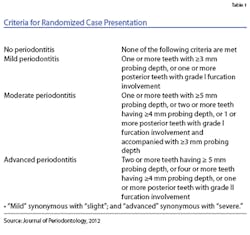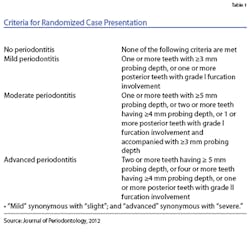PEARL Studies Target Dental Diagnosis Trends
By LYNNE SLIM, RDH, BSDH, MSDH
Last October, I was scheduled to speak at the New Hampshire Dental Hygienists’ Association Annual Session with Ashley C. Grill, RDH, MPH. On the night before the presentation, I helped pack festive goody bags for course attendees at the home of Joan Fitzgerald, RDH, BS, a trusted friend and professional colleague. Halloween was in the air, so much so that I noticed the preoccupation of neighbors with bizarre plastic tombstones and creative epitaphs adorning their front yards!
Ashley and I enjoyed the day and found New Hampshire dental hygienists to be exceptionally hospitable, up until the middle of the afternoon when a nor’easter was starting to dump more than two feet of snow that very day. After packing up our collective gear and saying our goodbyes, Ashley mentioned in passing that she would be in touch with me again soon to discuss a Journal of Periodontology manuscript that was in the works. It was based on some applied research that was related to periodontal disease. Naturally, my ears perked up and I was like a child waiting for Santa to arrive with the long-awaited goods.
As coordinator at PEARL Network, New York University College of Dentistry, Ashley and other researchers’ efforts are “practice-based,” which are designed to study “everyday” issues in the practice and delivery of oral health care. PEARL Network (Practitioners Engaged in Applied Research and Learning) is an NIDCR-supported, practice-based research network that provides a unique pathway for modifying and advancing the dental profession. It is also a way to accelerate the incorporation of medical and oral health-care advances into clinical applications directed at patient care.1 This column will cover a recent, randomized case study that was designed to determine the degree of accuracy among 130 clinical practitioners (general dentists only) in diagnosing cases of periodontal disease.2
Ten different periodontal cases were created and randomized so that each of the general dentists was presented with five scenarios. The PEARL Network developed the cases in consultation with board certified periodontists. Standard information for each case included probing depths, bleeding on probing, bone loss, furcation involvement, mobility, clinical attachment loss, presence of calculus/plaque, and presence of inflammation. Diagnostic categories included health; gingivitis; mild, moderate, and severe periodontitis; or, as an alternative to a diagnosis, referral to a specialist.2 The survey also included questions about treatment recommendations such as oral hygiene instruction, polishing, mouth rinses, scaling and root planing, antibiotics, surgery, occlusal adjustment, and host response modification.
The design of the study used diagnostic criteria from the literature in consultation with board-certified periodontists and was reviewed by the NIDCR/NIH Protocol Review Committee (see Table 1). The diagnosis for each case was compared among the general dentists and with definitions of the AAP Parameters of Care and the Periodontal Treatment Protocol. General dentists compared the diagnosis for each case with definitions of the AAP Parameters of Care and the Periodontal Treatment Protocol.
Demographics of dentists included a representative distribution in age, gender, race, ethnicity, practice location, and number of active patients. The average age of the dentist was 53 years.
Study results indicated that dentists seem to refer to a specialist based on severity. As an example, for severe periodontitis, as many as 21% of general dentists referred to a specialist, 8% for moderate periodontitis, and 1% for mild periodontitis.
Dentist practitioners were consistent in their agreement only for severe periodontitis. For patients with a degree of severity other than severe periodontitis, a variety of diagnoses were selected, which could mean that too little or too much treatment would be planned. Investigators suggested that it was the lack of consensus in definitions of periodontitis that may have contributed to the variation in diagnosis by the dentist practitioners.
If there is a lack of consensus in the definitions of periodontitis (as suggested by the PEARL investigators and many others) and a significant variation in diagnosis, why might these research results be important to the practicing dental hyggienist? As direct providers of preventive care, dental hygienists should be aware that practitioners, including themselves, might not be accurately co-diagnosing periodontal diseases with dentists, which might result in some patients not receiving the treatment they need or some patients receiving treatment they do not need.
Dental hygienists are not immune from being named as codefendants in malpractice cases in which dentists are being sued for failure to diagnose periodontal disease. Professional liability claims pertaining to periodontics commonly allege failure to diagnose periodontal diseases, failure to inform, failure to refer or failure to treat. Competent dentists and dental hygienists are able to co-diagnose and treat a patient’s oral health needs and refer when it is in the patient’s best interest. Maintaining competence requires continual self-assessment about the outcome of patient care and involves a commitment to lifelong learning. RDH
References
1. Curro FA et al. The PBRN initiative: transforming new technologies to improve patient care. J Dent Res July 2012; 91: S12-S20.
2. Martin JA et al. Periodontal diagnosis affected by variation in terminology. J Periodontol 2012 Jun 15. (Epub ahead of print).
LYNNE SLIM, RDH, BSDH, MSDH, is an award-winning writer who has published extensively in dental/dental hygiene journals. Lynne is the CEO of Perio C Dent, a dental practice management company that specializes in the incorporation of conservative periodontal therapy into the hygiene department of dental practices. Lynne is also the owner and moderator of the periotherapist yahoo group: www.yahoogroups.com/group/periotherapist. Lynne speaks on the topic of conservative periodontal therapy and other dental hygiene-related topics. She can be reached at [email protected] or www.periocdent.com.
Past RDH Issues

